Arizona Vegetable & Fruit Gardening
For The Arizona Desert Environment.
Pictures, Photos, Images
Descriptions, Information, & Reviews.
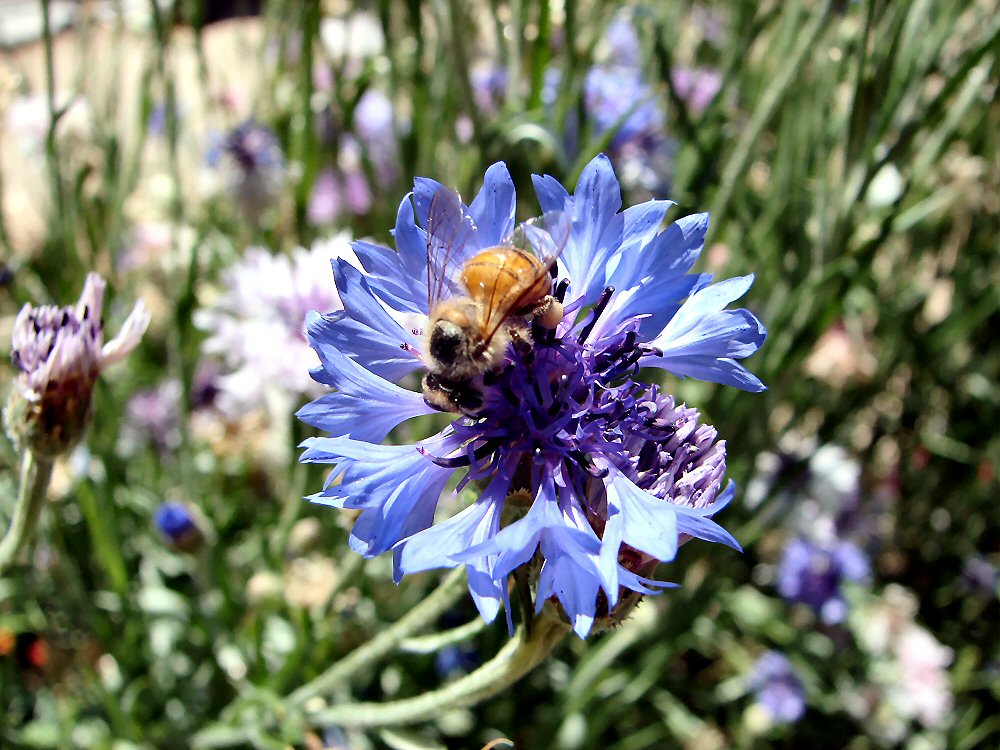 |
| Honey Bee, Apis mellifera On A Cornflower. Beneficial Or Good Insects In Arizona. |
|---|
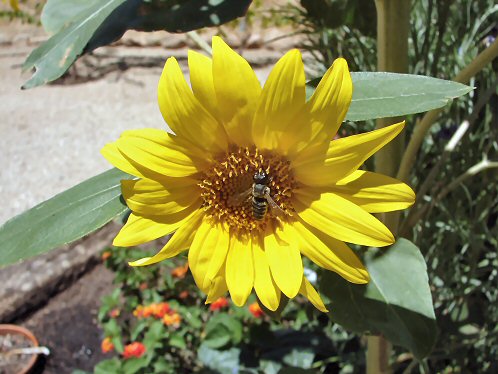 |  |
| Honey Bee, Apis mellifera On A Cornflower. Beneficial Or Good Insects In Arizona. | Bumble Bee or Bumblebee Genus Bombus On Cornflower. Beneficial Or Good Insects In Arizona. |
|---|
Beneficial Or Good Insects In Arizona.
Here Are Our Descriptions Of Some Of The More Common Beneficial Or Good Insects In Arizona.
|
No Attempt Here Is Made To Show All Of Them!! Photos & Descriptions Courtesy Of: Wikipedia, the free encyclopedia. Wikipedia also uses our information at no cost.
(Ants), Rough Harvester Ant, Pogonomyrmex rugosus.
The venom is presumed by scientists to be an anti-vertebrate defense, specifically against predators that have evolved to selectively feed on them, most notably the horned lizards. The horned lizards in Arizona are the most dangerous preditor to Rough Harvester Ants. In addition to horned lizards, there are predatory wasps in the genus Clypeadon which feed only on Pogonomyrmex workers, paralyzing them with their venom, and then carrying them back to a burrow where they will serve as food for the wasp's larva. You will know that you are near a Rough Harvester Ant colony since the areas around most Pogonomyrmex nests tend to be utterly devoid of vegetation, and are easily seen from a distance. There also may be several openings into the same nest. Each Rough Harvester Ant colony has a life-span of about 15 to 20 years, which is the life-span of its queen. (The sterile female workers live about a year, males for only a few weeks.) During her lifetime, a queen lays eggs in sufficient numbers to build the colony to a maximum population of about 10,000 within 5 or 6 years, the colony then maintains its numbers until the queen dies, after which the colony also dies, since there is no queen to keep it going. Every year, when the summer monsoon rains begin in full strength, all of the colonies in a local area will send their winged virgin queens and males out on a single mating flight, and each mated queen who survives will build a new nest and produce all of the new colony's future ants from the sperm of her single mating. This mating flight looks like a small cloud in the sky. It is interesting to watch! The Rough Harvester Ant forages for seeds usually peaks in the cool of morning, then again in early evening (with variations due to temperature and humidity). Rough Harvester Ant scouts explore the terrain, guided by visual landmarks, position of the sun, and odor marks. When a worker finds a patch of seeds she carries one back to the nest, depositing an odor trail from the tip of her abdomen (sting gland). Her nest mates then follow, often in large numbers, and if the food source persists, a trunk trail is developed, which can remain active for several weeks. The seeds provide food for their larvae inside the nest. A distinguishing feature of the Rough Harvester Ant is the psammophore, or basket of long hairs on the underside of the females head used for carrying sand grains. This structure enticed Austrian taxonomist Gustav Mayr to name this genus Pogonomyrmex, or "bearded ant". The Rough Harvester Ant is ecologically important as a scavenger and seed disperser. We have two nests in our yard and we just let them alone and they let us alone.
Antlions: Denizens Of The Sand, Glenurus luniger. Winged Adult Female. ------ Sand Trap.----
Antlions belong to the family Myrmeleontidae and include over 2,000 described species. The term "antlion" applies to the Larval form of the members of this family. Often, people call them Ant Lions. Or Doodlebugs. There is no consistant name for the Adult. Sometimes, the adults are called "antlion lacewings". The antlion larva is called "doodlebug" in North America because of the odd winding, spiralling trails it leaves in the sand while looking for a good location to build its trap, as these trails look like someone has doodled in the sand. If you look into the Nest or Trap on the groung you will find the Antlion larva, which is a ferocious-appearing creature with a robust, fusiform body bearing three pairs of walking legs and a slender neck. Its small head bears an enormous pair of sicklelike jaws (mandibles) with several sharp, teethlike projections. Like sharp hypodermic needles, the hollow jaws pierce the victim and suck fluids out of its body. According to R.E. Hutchins (Insects, 1966), the jaws are capable of injecting venom which digests and dissolves the body contents of the prey. The Antlion larva excavates a conical pit in the sand by crawling backwards in circles, at the same time flipping out sand grains with its long jaws. As it moves round and round, the pit gradually gets deeper and deeper. Eventually the crater reaches 2-4 centimeters across and almost as deep, with very steep walls. The slope of the funnel is adjusted to the critical angle of repose for sand, so that the sides readily give way under the feet of a would-be escapee, such as an ant or almost any other insect. The larva waits quietly at the bottom of the pit, with its body off to one side and concealed by the steep wall. Only its sicklelike jaws protrude from the sand and often they are in a wide-opened position. When crawling insects, fall into the pit it is almost impossible for them to climb the loose sand on the steep walls. The Antlion also quickly flips out more sand, thus deepening the pit and causing miniature landslides along the walls which knock the struggling insect to the bottom. Usually its struggle is hopeless when it is seized by the powerful jaws of the antlion. Often the struggling victim is pulled beneath the sand as its body fluids are gradually siphoned out. After consuming all the contents, the lifeless, dry carcass is flicked out of the pit, and the pit is readied for a new victim. Antlion pits are very common in sandy washes and riverbeds, beneath trees, such cottonwoods and willows, or under overhanging rocks. Photos Taken August 7, 2011.
Blue Orchard Mason Bee, Osmia lignaria.
Orchard mason bees, like all mason bees, are very shy and will only sting if the bee believes it is in serious danger. It will not attack to defend itself. The stinger itself is actually an egg guide. Many gardeners are now keeping small nests of these bees near their home gardens. They are very easy to keep and they will pollinate your garden or orchard. We have several links on this page to Amazon.Com, where you can buy inexpensive nests and the bees will then come to your garden to live! There are several growers of the bees where you can purchase them if you wish. Just do a Google Search for Blue Orchard Mason Bee, Osmia lignaria.
Cicada Killer Wasp, Sphecius speciosus.
This large wasp is actually a beneficial insect useful in the control of the noisy cicadas that also appear in July and August each year. Although they are quite menacing in appearance, The male cicada killer wasp may demonstrate aggressive-like behavior, darting back and forth, diving at people nearby and sometimes flying into windows. Fortunately, the male cannot sting. The female can sting, but is not usually aggressive toward people. She is often seen burrowing in the ground or in flight carrying the preferred victim of her powerful sting - a paralyzed cicada. The cicada killer is a solitary wasp, but several wasps and nests can often be found in the same immediate vicinity. The female cicada killer will dig a tunnel about � inch wide and 6-to-10 inches long, with several side chambers, in loose soil or sandy embankments. She may also be found burrowing between cracks on the sidewalk or driveway. Once the tunnel and chambers are dug, female cicada killers then fly, glide or drag the cicadas back to their nests to provide a food source for the larvae when the egg hatches. Then the tunnel is sealed. Little piles of soil mark the entrances to the nests, perhaps making quite a mess of a lawn or flower bed. After an egg hatches, the larva feeds on the cicada or cicadas that a female has provided for her young. The larva develops through several molts (instars) before pupating inside a woven, spindle-shaped brown case measuring up to 1� inches long. Winter is spent in the larval or pupal stage. Adults emerge in the summer, feed, mate and produce new nesting burrows. One generation occurs per year. While larvae feed only on cicadas, the adults will feed on flower nectar. Since the cicada killer wasp is a beneficial insect whose aboveground activity is limited to only a few months when cicadas are active, control is not necessary in most cases.
Desert Banded Centipede, Scolopendra polymorpha.
In the sense that he is a preditor of many pests, he is considered a beneficial insect, but you sure don't want to handle him if you see him in your garden. He is not considered dangerous to humans but he can give you a nasty bite that will hurt for quite a while! Some of the largest specimens can exceed 100 mm in length! They are considered among the top predators in the Sonoran Desert invertebrate community. In fact they are not averse to eating other predators such as scorpions, & spiders.
(Grasshopper) Lakin Grasshopper, Melanoplus lakinus.
The Lakin grasshopper ranges widely in western North America inhabiting several types of grasslands and desert shrub regions. Its occupancy of a site depends on the presence of a good supply of food plants, especially several members of the goosefoot family (Chenopodiaceae). Native host plants include species of Atriplex (saltbush) and probably some other species of this family. The Lakin grasshopper does not cause much damage to rangeland forage and in certain circumstances may be a beneficial species. During outbreaks; the Lakin grasshopper occasionally becomes a pest of alfalfa, wheat, vegetables, and ornamental flowers.
Honey Bees or Honeybees, Apis mellifera.
They are a subset of bees in the genus Apis, primarily distinguished by the production and storage of honey and the construction of perennial, colonial nests out of wax. Honey bees are the only extant members of the tribe Apini, all in the genus Apis. Currently, there are only seven recognised species of honey bee with a total of 44 subspecies, though historically, anywhere from six to eleven species have been recognised. Honey bees represent only a small fraction of the approximately 20,000 known species of bees. Some other types of related bees produce and store honey, but only members of the genus Apis are true honey bees. The author of this page, George deLange was a hobby beekeeper for many years and taught beekeeping in the Phoenix, Arizona area. He has even won the Best & Most Complete Award in Beekeeping at the Arizona State Fair in 1976. The Western honey bee or European honey bee (Apis mellifera) is a species of honey bee. The genus Apis is Latin for "bee", and mellifera comes from Latin melli- "honey" and ferre "to bear"�hence the scientific name means "honey-bearing bee". The name was coined in 1758 by Carolus Linnaeus who, realizing that the bees do not bear honey, but nectar, tried later to correct it to Apis mellifica ("honey-making bee") in a subsequent publication. However, according to the rules of synonymy in zoological nomenclature, the older name has precedence. As of October 28, 2006, the Honey Bee Genome Sequencing Consortium fully sequenced and analyzed the genome of Apis mellifera. Almost everyone knows that honeybees make honey and people think that honeymaking is the honeybee's chief value, but the honey bee's primary commercial value is as a pollinator of crops. Orchards and fields have grown larger; at the same time wild pollinators have dwindled. In several areas of the world, including the United States, the pollination shortage is compensated for by migratory beekeeping, with beekeepers supplying the hives of bees during the crop bloom and moving them after bloom is complete. This is so critical, since many crops will not produce without honeybee pollination. Bees, as well as some other insects, are particularly beneficial as pollinators to most plants, as they maintain flower constancy, which means they are more likely to transfer pollen to other conspecific plants. Also, flower constancy prevents the loss of pollen during interspecific flights and pollinators from clogging stigmas with pollen of other flower species. European honey bee populations and beekeepers have faced some very difficult problems over the past few years. 1. North American and European populations were severely depleted by varroa mite infestations in the early 1990s. 2. US beekeepers were further affected by colony collapse disorder in 2006 and 2007. 3. In 1956 African bees were brought to Brazil so that scientists there could try to develop a honey bee better adapted to tropical areas. Unfortunately, some of the bees escaped and began breeding with local Brazilian honey bees. Since 1957, these bees and their hybrid offspring, Africanized Honey Bees, have been multiplying and migrating to other regions. By 1990 they were in Hidalgo, Texas. Then they were found in Arizona and New Mexico in 1993. This caused many beekeepers to leave the business and reduced the number of bees available for commercial pollination.
Katydid, Greater Angle Wing, Microcentrum rhombifolium.
It averages between about 52 and 63 mm in length. They are green in color and have long antennae. The tarsi have four segments. Males have flat, round "ears' known as tympana at the base of their front tibiae. Females have a flat, sword-like ovipositor. They are found throughout the southwestern and eastern US where they live in a variety of habitats on deciduous trees and shrubs and they feed upon the leaves. The adults are active during late summer and early fall. Males and females can be distinguished by the hook-like ovipositor at the end of the female's abdomen. When mating occurs the male places a spermatophore at the female's genital opening. It takes about fifteen minutes for the sperm to transfer to the female's body. Their eggs are tan in color. The female glues them to the underside of leaves where they remain for two or three months until they hatch. The young - called nymphs - look like smaller versions of the adults only they are lacking wings. The young mature in about three to four months. Their predators include birds and some amphibians. Their coloration is used as a camouflage to evade them. However, if they are spotted by a preditor, they will take flight to escape. They usually are not a problem to your garden so we are placing them on the good insect page.
Leafcutter Bees, Megachile.
Praying Mantis, (Order Mantodea).
Praying Mantids are highly predacious, and their prayerful-looking front legs are modified into raptorial graspers that are used to capture their insect prey. They feed on a variety of insects, including moths, crickets, grasshoppers and flies. They lie in wait with the front legs in an upraised position. They intently watch and stalk their prey. They will eat each other. In fact, the adult female usually eats the male after or during mating. Many fish and predatory aquatic insects eat larvae and pupae. Bats, birds and spiders eat flying adults.
Despite their fearsome appearance, Praying Mantids are completely harmless to humans and they are actually highly beneficial because these very efficient hunters help to control insect pests in the garden or orchard.
Yellowjacket, genera Vespula and Dolichovespula.
Yellowjacket is the common name in North America for predatory wasps of the genera Vespula and Dolichovespula. Members of these genera are known simply as "wasps" in other English-speaking countries. Most Yellowjackets are black and yellow; some are black and white (such as the bald-faced hornet, Dolichovespula maculata), while others may have the abdomen background color red instead of black. They can be identified by their distinctive markings, small size (similar to a honey bee), their occurrence only in colonies, and a characteristic, rapid, side to side flight pattern prior to landing. All females are capable of stinging which can cause pain to the person who has been stung. Yellowjackets are very important to have in your garden since they are predators of pest insects. We use companion gardening methods to encourage Yellowjackets to come into our garden. They love cornflowers, so we plant them into our garden. This also encourages honeybees to come to the garden so they can pollinate our plants, such as melons.
Not all insects found in an apple orchard are pests. Many organisms benefit the grower by eating or parasitizing pests in the orchard. These organisms are known as beneficials, natural enemies, or biological control agents. They may be native or introduced from other areas.
Beneficial natural enemies (insects and mites) that may occur in an apple orchard could be classified as predators or parasitoids. Predators are those that attack, kill, and feed directly on a pest (prey). Examples of common orchard predators are ladybeetles, flies, lacewings, wasps, bugs, ants, spiders, and predator mites. Parasitoids are insects that lay eggs on or in a pest (host). The developing larva lives and feeds on the host, parasitizing and eventually killing it. Examples include parasitic wasps such as the egg parasite, Trichogramma sp.
Bees are a different class of beneficial insects in the orchard in that they benefit the grower by aiding pollination.
It is important that growers are able to recognize, identify, and conserve beneficials in their orchard. Conservation of beneficial organisms is a basic tenet of an ecologically sound pest management strategy. Conservation or enhancement of beneficials can be achieved through judicious use of pesticides such as spraying only when and where needed, accurate timing of sprays, and selecting pesticides that are least toxic to beneficials.
For Example: Many growers now place colonies of the Blue Orchard Mason bees in their orchards to pollinate their crops for maximum production.
A great resource about wasps of Arizona, to click on is the booklet in pdf called Wasp Management by Dawn H. Gouge, Carl Olson (University of Arizona), and Jose M. Rodriguez (Arizona Department of Environmental Quality).
|


Here Are Some Links To The Very Best & Most Popular Items Sold On Amazon.Com
To Learn More! Click The Links Below. No Obligation, Of Course!


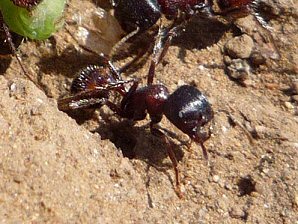 Pogonomyrmex is a genus of harvester ants, occurring primarily in the deserts of North and South America. Rough harvester ants are found over a wide area of Mexico and parts of California, Colorado, Nevada, New Mexico, Oklahoma, Texas and Utah. The Pogonomyrmex species (SubFamily Myrmicinae) are the most prominent Harvesters in Arizona, and they display an extreme aggressive behavior, using both their powerful, seed-cropping mandibles to bite encroaching predators, and an autotomizing sting (one which breaks off in the body of the victim) that injects the most toxic venom of any known insect poison (at least to mammals, including humans, who find their sting even more painful than that of southern Fire Ants). In sufficient quantity, these stings can be deadly to many kinds of small animals.
Pogonomyrmex is a genus of harvester ants, occurring primarily in the deserts of North and South America. Rough harvester ants are found over a wide area of Mexico and parts of California, Colorado, Nevada, New Mexico, Oklahoma, Texas and Utah. The Pogonomyrmex species (SubFamily Myrmicinae) are the most prominent Harvesters in Arizona, and they display an extreme aggressive behavior, using both their powerful, seed-cropping mandibles to bite encroaching predators, and an autotomizing sting (one which breaks off in the body of the victim) that injects the most toxic venom of any known insect poison (at least to mammals, including humans, who find their sting even more painful than that of southern Fire Ants). In sufficient quantity, these stings can be deadly to many kinds of small animals.


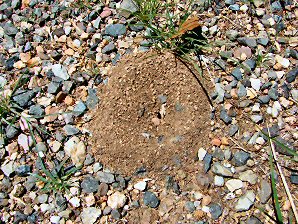 Usually in August the beautiful, winged adult Antlion crawls out of its underground pupal case and soon flutters away in search of a mate. Since they are active at night (nocturnal), the adult Antlions are attracted to lights, and their odds of finding a mate may increase on a neon sign or window screen.
Usually in August the beautiful, winged adult Antlion crawls out of its underground pupal case and soon flutters away in search of a mate. Since they are active at night (nocturnal), the adult Antlions are attracted to lights, and their odds of finding a mate may increase on a neon sign or window screen.
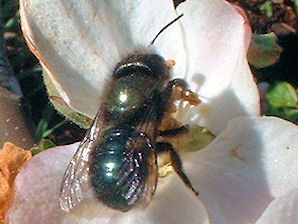 The Blue Orchard Mason Bee, Osmia lignaria, commonly known as the orchard mason bee or blue orchard bee, is a megachilid bee that makes nests in reeds and natural holes, creating individual cells for their brood that are separated by mud dividers. They are unlike carpenter bees in that they cannot drill holes in wood. O. lignaria is a common species used for pollination.
The Blue Orchard Mason Bee, Osmia lignaria, commonly known as the orchard mason bee or blue orchard bee, is a megachilid bee that makes nests in reeds and natural holes, creating individual cells for their brood that are separated by mud dividers. They are unlike carpenter bees in that they cannot drill holes in wood. O. lignaria is a common species used for pollination.
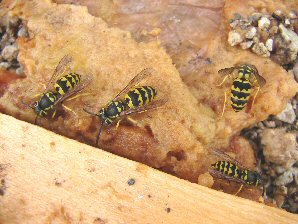
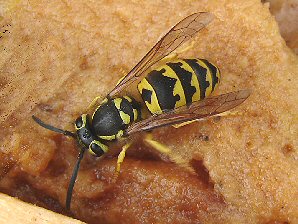 The Cicada Killer Wasp, Sphecius speciosus is up to 1� inches in length, with a black or dark brown body and yellow band markings around the abdomen. The head and thorax are a dark rusty red and the wings are amber.
The Cicada Killer Wasp, Sphecius speciosus is up to 1� inches in length, with a black or dark brown body and yellow band markings around the abdomen. The head and thorax are a dark rusty red and the wings are amber.
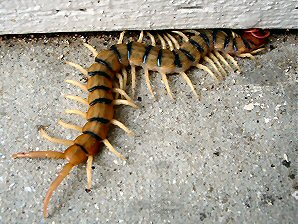 The Desert Banded Centipede, Scolopendra polymorpha; AKA Common Desert Centipede, or tiger centipede is rather common in the Sonoran Desert and nearby deserts of the southwest and it emerges on warm nights to hunt crickets, termites and other arthropods.
The Desert Banded Centipede, Scolopendra polymorpha; AKA Common Desert Centipede, or tiger centipede is rather common in the Sonoran Desert and nearby deserts of the southwest and it emerges on warm nights to hunt crickets, termites and other arthropods.
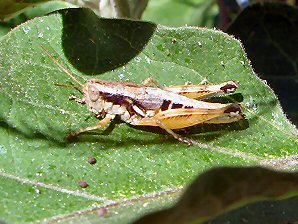 The Lakin Grasshopper, Melanoplus lakinus is considered neither good nor bad in Arizona. We are including him on this page since many gardeners become concerned when grasshoppers come into their gardens.
The Lakin Grasshopper, Melanoplus lakinus is considered neither good nor bad in Arizona. We are including him on this page since many gardeners become concerned when grasshoppers come into their gardens.
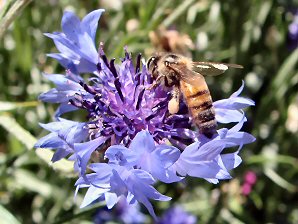
 The Honey bees (or honeybees) are probably the best well known beneficial insect, known to man.
The Honey bees (or honeybees) are probably the best well known beneficial insect, known to man.
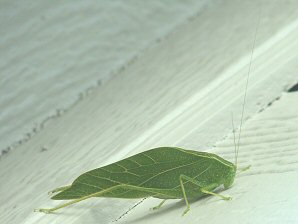
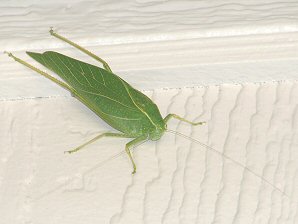 The Greater Angle Wing Katydid, Microcentrum rhombifoliumlso known as the Broad-winged Katydid, is one of six representatives of its genera in the United States.
The Greater Angle Wing Katydid, Microcentrum rhombifoliumlso known as the Broad-winged Katydid, is one of six representatives of its genera in the United States.
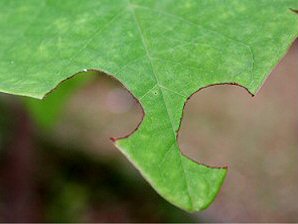
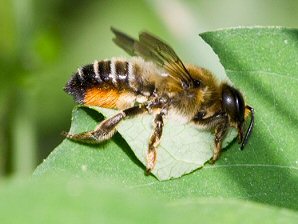 Leaf-cutter Bees are very common in the Sonoran Desert, especially around the urban areas of Tucson, Scottsdale, Tempe, and Phoenix. Flowering landscape shrubs such as lantana produce nectar and pollen which these bees gather for their young. They cut circular and oblong segments from leaves (bougainvillea a favorite) and use them to construct cylindrical tubes, about the diameter of a pencil, divided into cells. Each cell is packed with a mixture of pollen and honey plus one egg. Within each cell the egg hatches, develops as a grub, and finally metamorphoses into an adult bee. Thus the bees do not eat leaves and importantantly each bee is responsible for its own solitary nest. They rarely if ever sting people and are vital pollinators of vegetables and fruits in our gardens.
Leaf-cutter Bees are very common in the Sonoran Desert, especially around the urban areas of Tucson, Scottsdale, Tempe, and Phoenix. Flowering landscape shrubs such as lantana produce nectar and pollen which these bees gather for their young. They cut circular and oblong segments from leaves (bougainvillea a favorite) and use them to construct cylindrical tubes, about the diameter of a pencil, divided into cells. Each cell is packed with a mixture of pollen and honey plus one egg. Within each cell the egg hatches, develops as a grub, and finally metamorphoses into an adult bee. Thus the bees do not eat leaves and importantantly each bee is responsible for its own solitary nest. They rarely if ever sting people and are vital pollinators of vegetables and fruits in our gardens.
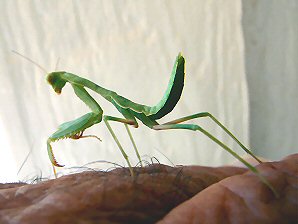
 There are a number of species of Praying Mantis found here in Arizona, and depending upon the species, they are either brown, yellowish, or green-colored like this Praying Mantis that I spotted outside of my kitchen door one morning.
There are a number of species of Praying Mantis found here in Arizona, and depending upon the species, they are either brown, yellowish, or green-colored like this Praying Mantis that I spotted outside of my kitchen door one morning.
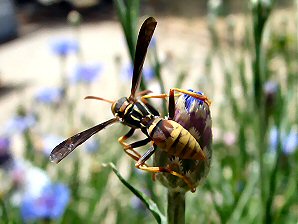
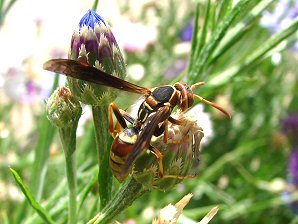 Ouch! The most painfull sting I ever got; next to a scorpion; was from a Yellowjacket.
But, the Yellowjacket of the genera Vespula and Dolichovespula is strongly considered a beneficial insect to our gardens! Just don't let the her sting you! It hurts!
Ouch! The most painfull sting I ever got; next to a scorpion; was from a Yellowjacket.
But, the Yellowjacket of the genera Vespula and Dolichovespula is strongly considered a beneficial insect to our gardens! Just don't let the her sting you! It hurts!